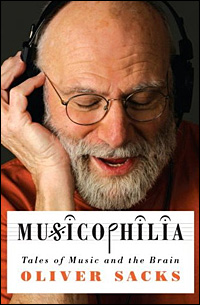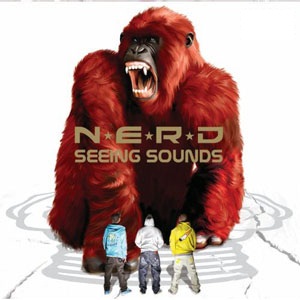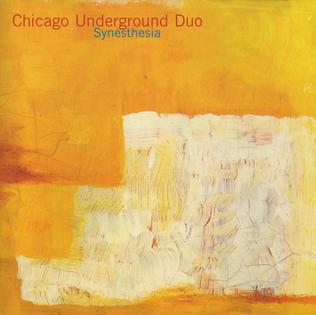
The clavier à lumières, or tastiera per luce, as it appears in the score, was a musical instrument invented by Alexander Scriabin for use in his work Prometheus: Poem of Fire. However, only one version of this instrument was constructed, for the performance of Prometheus: Poem of Fire in New York City in 1915. The instrument was supposed to be a keyboard, with notes corresponding to colors as given by Scriabin's synesthetic system, specified in the score, However, numerous synesthesia researchers have cast doubt on the claim that Scriabin was a synesthete.
Visual music, sometimes called colour music, refers to the use of musical structures in visual imagery, which can also include silent films or silent Lumia work. It also refers to methods or devices which can translate sounds or music into a related visual presentation. An expanded definition may include the translation of music to painting; this was the original definition of the term, as coined by Roger Fry in 1912 to describe the work of Wassily Kandinsky. There are a variety of definitions of visual music, particularly as the field continues to expand. In some recent writing, usually in the fine art world, visual music is often confused with or defined as synaesthesia, though historically this has never been a definition of visual music. Visual music has also been defined as a form of intermedia.
Synesthesia is a neurological condition in which two or more bodily senses are coupled. For example, in a form of synesthesia known as grapheme-color synesthesia, letters or numbers may be perceived as inherently colored. Historically, the most commonly described form of synesthesia has been between sound and vision, e.g. the hearing of colors in music.
Lexical-gustatory synesthesia is a rare form of synesthesia in which spoken and written language causes individuals to experience an automatic and highly consistent taste/smell. The taste is often experienced as a complex mixture of both temperature and texture. For example, in a particular synaesthete, JIW, the word jail would taste of cold, hard bacon. Synesthetic tastes are evoked by an inducer/concurrent complex. The inducer is the stimulus that activates the sensation and the taste experience is the concurrent.
The phrase synesthesia in art has historically referred to a wide variety of artists' experiments that have explored the co-operation of the senses in the genres of visual music, music visualization, audiovisual art, abstract film, and intermedia. The age-old artistic views on synesthesia have some overlap with the current neuroscientific view on neurological synesthesia, but also some major differences, e.g. in the contexts of investigations, types of synesthesia selected, and definitions. While in neuroscientific studies synesthesia is defined as the elicitation of perceptual experiences in the absence of the normal sensory stimulation, in the arts the concept of synaesthesia is more often defined as the simultaneous perception of two or more stimuli as one gestalt experience. The usage of the term synesthesia in art should, therefore, be differentiated from neurological synesthesia in scientific research. Synesthesia is by no means unique to artists or musicians. Only in the last decades have scientific methods become available to assess synesthesia in persons. For synesthesia in artists before that time one has to interpret (auto)biographical information. For instance, there has been debate on the neurological synesthesia of historical artists like Kandinsky and Scriabin. Additionally, Synesthetic art may refer to either art created by synesthetes or art created to elicit synesthetic experience in the general audience.
Synesthesia is a neurological condition in which one or more sensory modalities become linked. However, for over a century, the term synesthesia has also been used to refer to artistic and poetic devices which attempt to express a linkage between the senses. To better understand the influence of synesthesia in popular culture and the way it is viewed by non-synesthetes, it is informative to examine books in which one of the main characters is portrayed as experiencing synesthesia. In addition to these fictional portrayals, the way in which synesthesia is presented in non-fiction books to non-specialist audiences is instructive. Author and synesthete Patricia Lynne Duffy has described four ways in which synesthete characters have been used in modern fiction.

Chromesthesia or sound-to-color synesthesia is a type of synesthesia in which sound involuntarily evokes an experience of color, shape, and movement. Individuals with sound-color synesthesia are consciously aware of their synesthetic color associations/perceptions in daily life. Synesthetes that perceive color while listening to music, experience the colors in addition to the normal auditory sensations. The synesthetic color experience supplements, but does not obscure real, modality-specific perceptions. As with other forms of synesthesia, individuals with sound-color synesthesia perceive it spontaneously, without effort, and as their normal realm of experience. Chromesthesia can be induced by different auditory experiences, such as music, phonemes, speech, and/or everyday sounds.
Synesthesia is a neurologically based phenomenon in which stimulation of one sensory or cognitive pathway leads to automatic, involuntary experiences in a second sensory or cognitive pathway. There are many occurrences of synesthesia in books, television and film.

In 2007 neurologist Oliver Sacks released his book Musicophilia: Tales of Music and the Brain in which he explores a range of psychological and physiological ailments and their intriguing connections to music. It is broken down into four parts, each with a distinctive theme; part one titled Haunted by Music examines mysterious onsets of musicality and musicophilia. Part two A Range of Musicality looks at musical oddities musical synesthesia. Parts three and four are pretty self explanatory, titled Memory, Movement, and Music and Emotions, Identity, and Music respectively. Each part has between six and eight chapters, each of which is in turn dedicated to a particular case study that fit the overarching theme of the section. Presenting the book in this fashion makes the reading a little disjointed if one is doing so cover to cover, however, it also means one may pick up the book and flip to any chapter for a quick read without losing any context. Four case studies from the book are featured in the NOVA program Musical Minds aired on June 30, 2009.

Seeing Sounds is the third studio album by American alternative rock band N.E.R.D released June 10, 2008 on Star Trak Entertainment and Interscope Records in the United States. After ending their contract with Virgin Records in 2005, the band felt their previous album Fly or Die (2004) was too consistent. Using their own money, the band recorded the album in Florida and California. The album was produced solely by record production duo The Neptunes, consisting of Pharrell Williams and Chad Hugo, with additional assistance by rock band Spymob and was mainly written by Williams. The album's title, as well as its content, revolves around the neurological phenomenon of synesthesia, the mixing of sensory modalities.

Synesthesia or synaesthesia is a perceptual phenomenon in which stimulation of one sensory or cognitive pathway leads to involuntary experiences in a second sensory or cognitive pathway. People who report a lifelong history of such experiences are known as synesthetes. Awareness of synesthetic perceptions varies from person to person. In one common form of synesthesia, known as grapheme–color synesthesia or color–graphemic synesthesia, letters or numbers are perceived as inherently colored. In spatial-sequence, or number form synesthesia, numbers, months of the year, or days of the week elicit precise locations in space, or may appear as a three-dimensional map. Synesthetic associations can occur in any combination and any number of senses or cognitive pathways.

Ideasthesia was introduced by neuroscientist Danko Nikolić and is defined as a phenomenon in which activations of concepts (inducers) evoke perception-like experiences (concurrents). The name comes from the Ancient Greek ἰδέα (idéa) and αἴσθησις (aísthēsis), meaning "sensing concepts" or "sensing ideas". The main reason for introducing the notion of ideasthesia was the problems with synesthesia. While "synesthesia" means "union of senses", empirical evidence indicated that this was an incorrect explanation of a set of phenomena traditionally covered by this heading. Syn-aesthesis denoting also "co-perceiving", implies the association of two sensory elements with little connection to the cognitive level. However, according to others, most phenomena that have inadvertently been linked to synesthesia in fact are induced by the semantic representations. That is, the meaning of the stimulus is what is important rather than its sensory properties, as would be implied by the term synesthesia. In other words, while synesthesia presumes that both the trigger (inducer) and the resulting experience (concurrent) are of sensory nature, ideasthesia presumes that only the resulting experience is of sensory nature while the trigger is semantic. Meanwhile, the concept of ideasthesia developed into a theory of how we perceive and the research has extended to topics other than synesthesia — as the concept of ideasthesia turned out applicable to our everyday perception. Ideasthesia has been even applied to the theory of art. Research on ideasthesia bears important implications for solving the mystery of human conscious experience, which, according to ideasthesia, is grounded in how we activate concepts.

Autonomous sensory meridian response (ASMR), sometimes auto sensory meridian response, is a tingling sensation that typically begins on the scalp and moves down the back of the neck and upper spine. A pleasant form of paresthesia, it has been compared with auditory-tactile synesthesia and may overlap with frisson.

"Synesthesia" is a song and the debut single from Andrew McMahon's debut solo EP The Pop Underground, released on April 2, 2013 as a digital download and first physically available in the deluxe preorder package of The Pop Underground as a 7" picture disc. The single marks McMahon's first single release separated from his prior bands Something Corporate and Jack's Mannequin, as well as his commissioned writing for Smash, and also his first single as an independent artist. The single is produced and mixed by Tony Hoffer and written by McMahon and Mark Williams.

Frans Zimmer, better known by his stage name Alle Farben is a German DJ and producer. Since 2014 Zimmer is signed to the record label Guesstimate/b1 Recordings and the publishing house Budde Music.
Greg Jarvis is a Toronto born musician and composer best known for his work leading the orchestral rock group the Flowers Of Hell. Jarvis’s compositions are largely informed by timbre-to-shape synesthesia, a neurological condition which causes him to see all sounds as layers of three dimensional shapes.
Jack Coulter is a Northern Irish abstract expressionist artist. He is widely known for his paintings and the visceral quality within his work. In 2020, Coulter was described by the Financial Times as one of the most popular abstract painters emerging today. His pieces sell for upwards of £10,000.

Without Words: Synesthesia is the second remix album by Bethel Music, the second release in their Without Words series, and their eleventh album, overall. The album was released on July 31, 2015 via the collective's imprint label, Bethel Music. Bobby Strand and Chris Greely produced the album.

Synesthesia is an album by Chicago Underground Duo which was recorded in 1999 and released on the Delmark label the following year.









